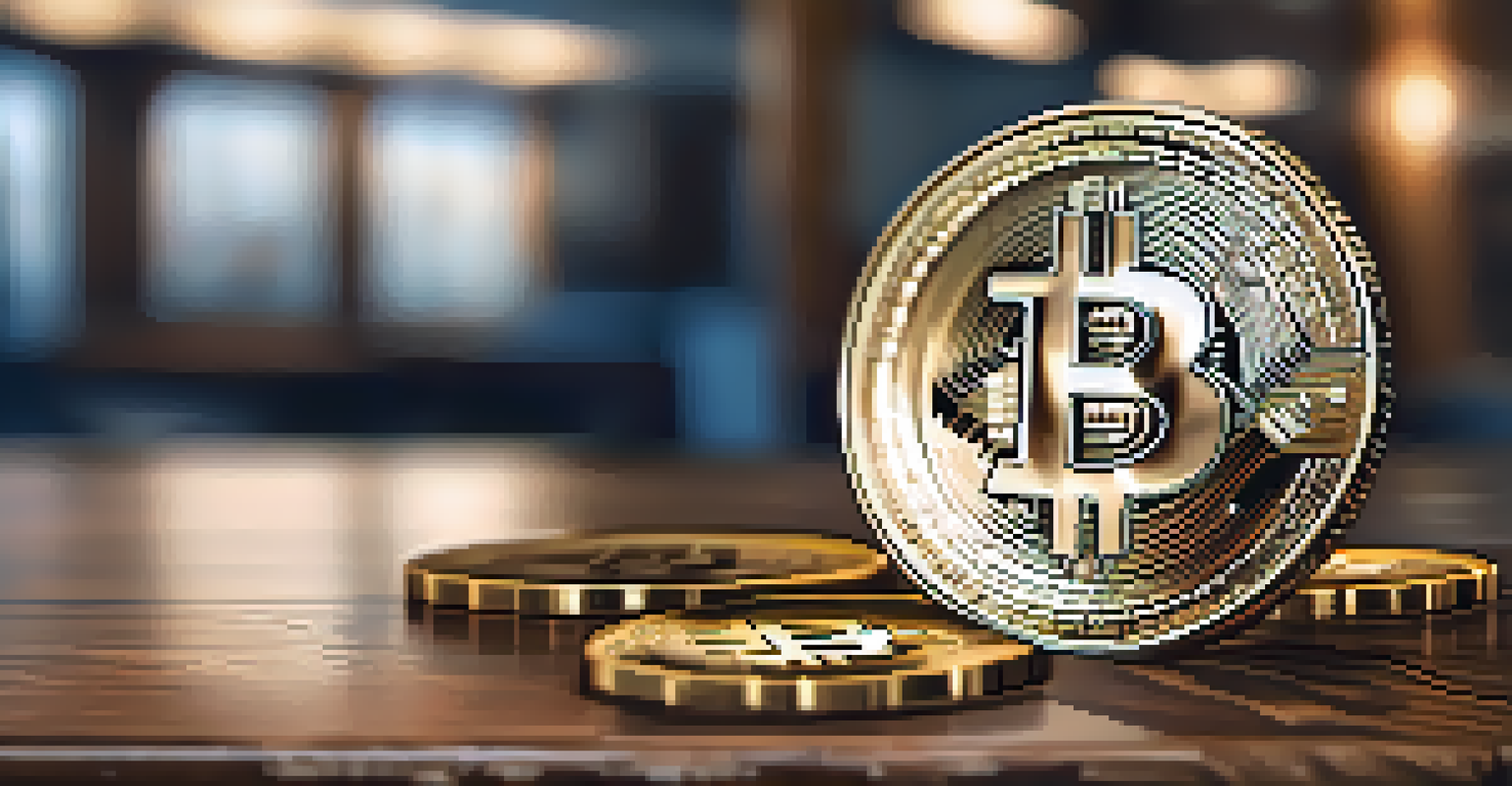Understanding Bitcoin's Role in Digital Collectibles Market

What Are Digital Collectibles and Why They Matter
Digital collectibles, often referred to as NFTs (non-fungible tokens), are unique digital items that can represent art, music, or even virtual real estate. Unlike traditional collectibles, these items exist on a blockchain, providing proof of ownership and authenticity. This unique aspect has made them incredibly popular, especially among artists and collectors who want to monetize or showcase their creations.
The internet is becoming the town square for the global village of tomorrow.
The appeal of digital collectibles lies in their rarity and the connection between buyers and sellers. Just like baseball cards or rare stamps, digital collectibles can hold significant value based on their uniqueness and demand. As more people embrace digital ownership, the market for these collectibles continues to grow, creating new opportunities for creators and investors alike.
With the rise of platforms dedicated to buying and selling NFTs, the landscape of collecting is evolving. Collectors can now easily trade their items in a global marketplace, further enhancing the community aspect of digital collectibles.
Bitcoin: The Pioneer of Cryptocurrency
Bitcoin, introduced in 2009 by an anonymous entity known as Satoshi Nakamoto, was the first cryptocurrency and remains the most well-known. It operates on a decentralized network, allowing transactions to occur without the need for intermediaries like banks. This revolutionary concept laid the groundwork for other cryptocurrencies and the broader blockchain ecosystem, including digital collectibles.

As the original cryptocurrency, Bitcoin has established itself as a store of value, often compared to gold. Investors view it as a hedge against inflation and economic instability, driving its adoption and popularity. This foundational status has also influenced how other digital assets, including NFTs, are perceived in the market.
Digital Collectibles Explained
Digital collectibles, or NFTs, are unique items on a blockchain that offer proof of ownership and authenticity, attracting collectors and creators.
The success of Bitcoin has encouraged the development of various blockchain technologies, which now support a wide array of digital collectibles. This relationship signifies how Bitcoin's growth has paved the way for innovations in the digital art and collectibles space.
The Intersection of Bitcoin and Digital Collectibles
Bitcoin and digital collectibles share a common foundation: blockchain technology. This decentralized ledger system ensures transparency and security, making it possible to verify ownership of digital assets. As a result, Bitcoin has not only influenced the way digital collectibles are created but also how they are bought and sold.
Innovation distinguishes between a leader and a follower.
Many platforms that facilitate the trading of digital collectibles accept Bitcoin as a form of payment. This provides collectors with more options and flexibility when it comes to transactions. As Bitcoin continues to gain traction, its role in the digital collectibles market becomes increasingly significant.
Additionally, the use of Bitcoin can simplify cross-border transactions. This means that a collector in one part of the world can easily purchase a digital collectible from someone on the other side of the globe without the hassles of currency conversion or international banking fees.
The Benefits of Using Bitcoin for Digital Collectibles
One of the primary advantages of using Bitcoin in the digital collectibles market is the increased security it offers. Transactions made with Bitcoin are recorded on a blockchain, making them virtually tamper-proof. This high level of security helps to protect both buyers and sellers, fostering trust within the marketplace.
Moreover, Bitcoin transactions are generally faster and cheaper than traditional banking methods. This efficiency is particularly beneficial for collectors and artists who want to minimize fees and maximize their profits. As the digital collectibles market continues to expand, the need for efficient transaction methods will only grow.
Bitcoin's Role in Collectibles
Bitcoin serves as a secure and efficient payment method for digital collectibles, facilitating global transactions and enhancing market accessibility.
Lastly, using Bitcoin can open up new avenues for collectors who might not have access to traditional banking systems. This inclusivity is vital in a global marketplace where anyone can participate, regardless of their location or financial background.
Challenges of Integrating Bitcoin in Digital Collectibles
While Bitcoin offers numerous benefits for the digital collectibles market, it also presents some challenges. One of the most significant issues is its price volatility. The value of Bitcoin can fluctuate dramatically in a short period, which can create uncertainty for both buyers and sellers when pricing digital assets.
Additionally, the environmental concerns surrounding Bitcoin mining have sparked debates within the community. The energy-intensive process of mining Bitcoin can have negative impacts on the environment, leading some to question its sustainability as a payment method for digital collectibles.
Lastly, regulatory uncertainties can pose challenges as well. Different countries have varying regulations regarding cryptocurrencies, which could affect how digital collectibles are bought and sold. This inconsistency can create confusion for collectors and creators trying to navigate the market.
The Future of Bitcoin and Digital Collectibles
Looking ahead, the relationship between Bitcoin and digital collectibles is likely to evolve. As more people become familiar with blockchain technology, the demand for digital collectibles will likely increase. This growing interest could lead to more innovative uses of Bitcoin within this space, enhancing the overall experience for collectors.
We may also see the emergence of new platforms that combine Bitcoin with digital collectibles, offering unique features that cater to both buyers and sellers. These platforms could leverage the benefits of Bitcoin's security and efficiency while addressing its challenges, creating a more robust marketplace.
Challenges of Bitcoin Integration
Despite its advantages, Bitcoin's price volatility, environmental impact, and regulatory uncertainties pose challenges for the digital collectibles market.
As the digital collectibles landscape matures, Bitcoin will undoubtedly play a crucial role. The synergy between these two entities could reshape the way we think about ownership and value in the digital realm.
Final Thoughts on Bitcoin in the Digital Collectibles Market
In conclusion, Bitcoin has established itself as a pivotal player in the digital collectibles market. Its unique features, such as security, efficiency, and global reach, have made it an appealing option for collectors and creators alike. As the market continues to grow and evolve, Bitcoin's influence will likely become even more pronounced.
While challenges exist, the potential for innovation and new opportunities in this space is significant. Collectors and artists must stay informed and adapt to the changing landscape, taking advantage of the benefits that Bitcoin offers.

Ultimately, the intersection of Bitcoin and digital collectibles represents a fascinating new frontier in the world of digital assets, encouraging creativity, community, and investment in a way that was unimaginable just a decade ago.